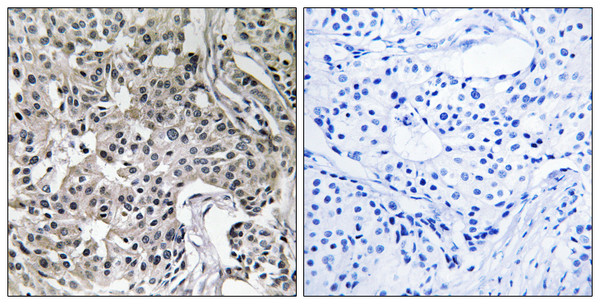| Host: | Rabbit |
| Applications: | WB/IHC/IF/ELISA |
| Reactivity: | Human/Mouse/Rat |
| Note: | STRICTLY FOR FURTHER SCIENTIFIC RESEARCH USE ONLY (RUO). MUST NOT TO BE USED IN DIAGNOSTIC OR THERAPEUTIC APPLICATIONS. |
| Short Description : | Rabbit polyclonal antibody anti-Ubiquitin carboxyl-terminal hydrolase 19 (391-440 aa) is suitable for use in Western Blot, Immunohistochemistry, Immunofluorescence and ELISA research applications. |
| Clonality : | Polyclonal |
| Conjugation: | Unconjugated |
| Isotype: | IgG |
| Formulation: | Liquid in PBS containing 50% Glycerol, 0.5% BSA and 0.02% Sodium Azide. |
| Purification: | The antibody was affinity-purified from rabbit antiserum by affinity-chromatography using epitope-specific immunogen. |
| Concentration: | 1 mg/mL |
| Dilution Range: | WB 1:500-1:2000IHC 1:100-1:300ELISA 1:20000IF 1:50-200 |
| Storage Instruction: | Store at-20°C for up to 1 year from the date of receipt, and avoid repeat freeze-thaw cycles. |
| Gene Symbol: | USP19 |
| Gene ID: | 10869 |
| Uniprot ID: | UBP19_HUMAN |
| Immunogen Region: | 391-440 aa |
| Specificity: | USP19 Polyclonal Antibody detects endogenous levels of USP19 protein. |
| Immunogen: | The antiserum was produced against synthesized peptide derived from the human USP19 at the amino acid range 391-440 |
| Protein Name | Ubiquitin Carboxyl-Terminal Hydrolase 19Deubiquitinating Enzyme 19Ubiquitin Thioesterase 19Ubiquitin-Specific-Processing Protease 19Zinc Finger Mynd Domain-Containing Protein 9 |
| Database Links | Reactome: R-HSA-5689880 |
| Cellular Localisation | Endoplasmic Reticulum MembraneSingle-Pass Membrane ProteinAccumulates In The Mitochondria-Associated Er Membrane (Mam) In Response To Hypoxia |
| Alternative Antibody Names | Anti-Ubiquitin Carboxyl-Terminal Hydrolase 19 antibodyAnti-Deubiquitinating Enzyme 19 antibodyAnti-Ubiquitin Thioesterase 19 antibodyAnti-Ubiquitin-Specific-Processing Protease 19 antibodyAnti-Zinc Finger Mynd Domain-Containing Protein 9 antibodyAnti-USP19 antibodyAnti-KIAA0891 antibodyAnti-ZMYND9 antibody |
Information sourced from Uniprot.org











